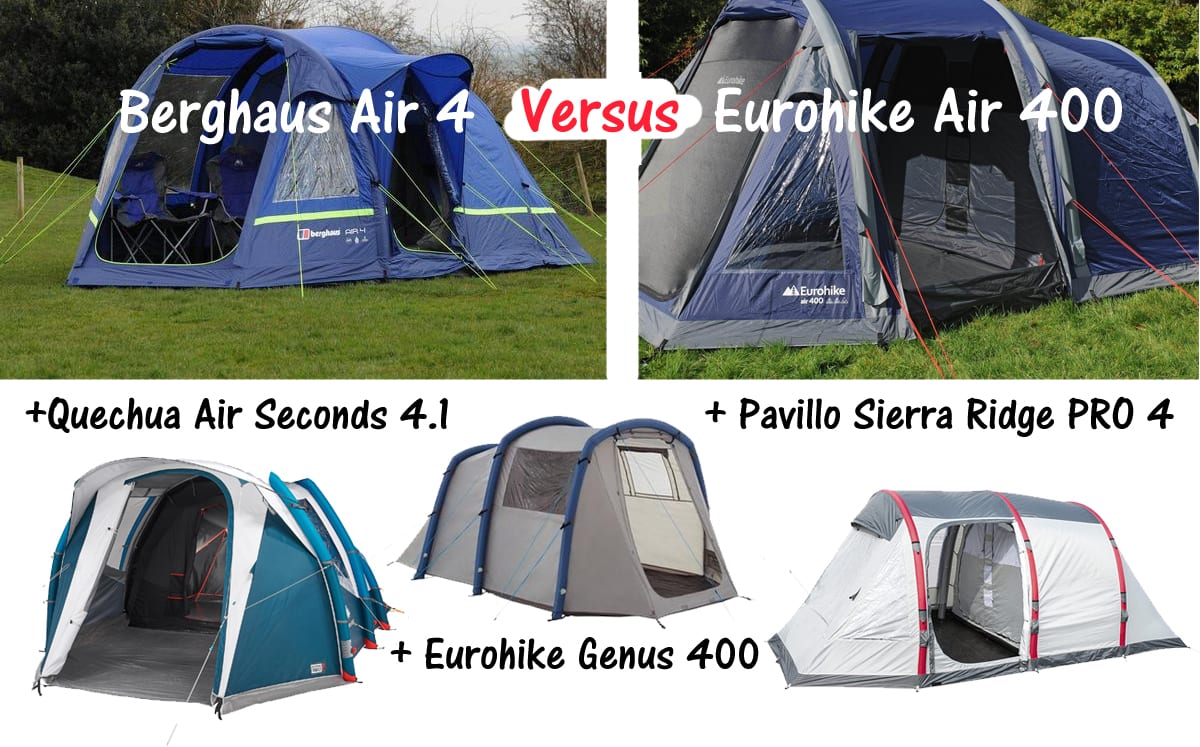Head to head comparison of the three plus two, highly popular, entry level 4-person inflatable (air) tents. There are two surprise contenders: in addition to comparing Eurohike Genus 400 Air vs Berghaus Air 4 vs Eurohike Air 400, I have also included the Quechua Air Seconds 4.1 and the Pavillo Sierra Ridge Pro 4 air tents in this review / comparison.
All 5 are very basic, small family tents with inflatable beams, ideal for beginners for a quick weekend getaway, occasionally used throughout the warmer months when weather allows. In theory, they should be able to sleep 4 adults; however they are probably more ideal for a family of 3 to 4 (with two smaller children), or for couples. They are designed to withstand moderately severe weather and should be waterproof, but the expectations at this price range should not be very high.
So if you just looking to buy your first inflatable tent, but can’t decide, or unsure whether it is safe to buy one of the cheapest 4-person air tents on the market, stay with me.
About the scoring
The scoring is very straightforward: I review and rank the air tents under every section and each get a point or points according to their rank. The overall winner is the one with the least points. I compared them in 5 categories;
- Price – the cheapest small family air tent
- Size – a small family air tent with the most space
- Weather protection – the small family air tent with the best weather resilience
- User-friendliness – the best small family air tent with the most features and ease of use
- Upgrades and extras
Summary – the best small family air tent (entry level)
1. The Winner: Berghaus Air 4 (9 points)
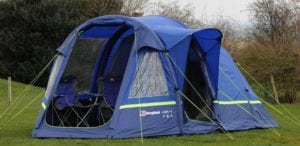
Berghaus Air 4
The Berghaus Air 4 came out first in almost every category, so perhaps not a surprise, the clear winner was the Berghaus Air 4. After all it is the most expensive tent of the 5 reviewed here – twice as expensive as the cheapest Eurohike Genus 400.
Whether or not that difference is justified? I am not entirely sure, but the Berghaus Air 4 is still not an expensive 4-berth tent, if you look at the 4-person small family air tents by the likes of Vango, Outwell or Kampa etc.
The Berghaus Air 4 has great all around properties – it is the biggest, sturdiest, most user-friendly among the 5.
I was a bit surprised though, that in the Berghaus Air 4 vs Eurohike Air 400 battle the former came out so clearly as the better tent.
Detailed review: Berghaus Air 4 & 4XL Inflatable Tent Review
Where to buy the Berghaus Air 4: Blacks | GoOutdoors
2. Value for Money – Eurohike Air 400 (13 points)
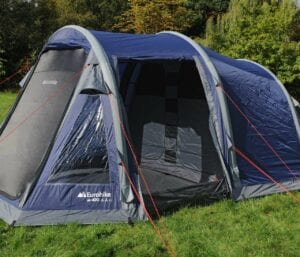
Eurohike Air 400
Despite that there’s nothing wrong with the Eurohike Air 400, it was not a steady 2nd and there are some areas where the other tents were simply better. If there’s anything, the Eurohike Air 400 is average in a positive sense, and being more than £100 cheaper than the Berghaus Air 4 I think it deserves the prize for providing really good value for the price.
Detailed Review: Eurohike Air 400 Review (All Questions Answered)
Where to buy the Eurohike Air 400: Blacks | GoOutdoors
3. Quechua Air Seconds 4.1 F&B (14 points)
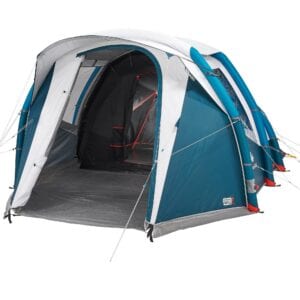
Quechua Air Seconds 4.1 F&B
If the Eurohike Air 400 was the ‘value for money’, than I don’t know what to call the Quechua Air Seconds 4.1. It is a decent tent with a lot of compromise, but if you consider what you actually need for your quick getaway – a place to sleep and some living area – than the Air Seconds 4.1 may be worth considering. If you are not going to be a frequent user, for the occasional camping weekends the Quechua might be just what you need – for a very reasonable price.
If you are on a strict budget, there is also a non-black-out version of it for £200.
The biggest drawback probably is the loose groundsheet, while the 5-year warranty puts it clearly ahead of the Genus 400.
Where to buy the Quechua Air Seconds 4.1 F&B: Decathlon
May be interesting: Quechua Air Seconds 6.3 XL (Full Review)
4. The cheapest: Eurohike Genus 400 (17 points)
Which tells everything you need to know about the Eurohike Genus 400. It does the job with a lot of BUT’s, and it does it for a really low price. However, if I had to pick between the Genus 400 and the Quechua Air Seconds 4.1, I’d definitely choose the latter.
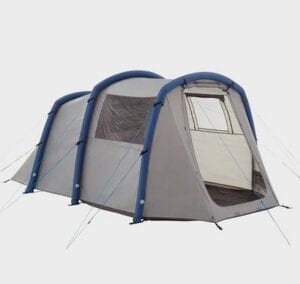
Eurohike Genus 400 cheap air tent
Where to buy the Eurohike Genus 400: Blacks | GoOutdoors
Detailed review: Eurohike Genus 400 Air Tent Review
May be interesting: Airgo Air Genus 800 Review
5. Pavillo Sierra Ridge PRO Air 4 (20 points)
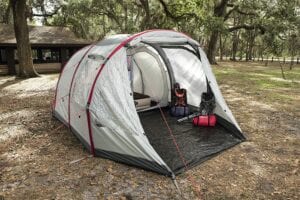
Pavillo Sierra Ridge PRO Air 4
The Pavillo did not come out well from this comparison. There are some good things about it like the 5000mm HH flysheet and its size, but even considering the subjective nature of this comparison (ie. I could have ranked it higher), it clearly belongs to the second half of the league table.
I would not say that I don’t recommend the Pavillo Sierra Ridge PRO, but in comparison with Eurohike Air 400 I’d prefer the Eurohike for the same price. The non-PRO version of the Pavillo Sierra Ridge may be worth considering because of its identical size and its side door – had it not been out of stock at the time of writing this, it certainly would have ranked higher in this comparison.
Where to buy the Pavillo Sierra Ridge: Sierra Ridge PRO Air 4 also: Sierra Ridge 4 Air
Detailed comparison of entry level small family air tents
Price
At the time of writing this comparison, the cheapest of the 5 is the Eurohike Genus 400. The Eurohike Genus 400 has been the cheapest on the market for a while now, despite being slightly more expensive than its predecessor, the Airgo Air Genus 400 (if I remember correctly, the Airgo Air Genus was sold for £199). However, you might be able to pick one up just under £200 at one of GoOutdoors’ sales events…
The cheapest small family air tent
- Eurohike Genus 400 £199 – £219 – 1 point
- Quechua Air Seconds 4.1 F&B £279 – 2 point
- Eurohike Air 400 £297 – £330 – 3 points
- Pavillo Sierra Ridge Pro 4 Air: £339 – 4 points
- Berghaus Air 4 £440 – 5 points
The Quechua came in second with its £279 RRP, however you must calculate with the cost of a decent pump (sold for £20 at Decathlon), as the pump is not included with the tent. Although, considering the quality of the pumps that sometimes come with the air tents, maybe it is not that big a loss. And it gives you the freedom of buying a decent hand pump or an electric pump. It is also worth noting, that there is a cheaper version of the Air Seconds 4.1, without the black-out bedrooms. The Quechua Air Seconds 4.1 is sold for £199 (plus pump).
The Eurohike Air 400 is normally around £330 at Blacks, Millets or GoOutdoors. However, sometimes, you can find some on Amazon for less, at the time of writing this there was one available under £300.
The Pavillo Sierra Ridge has a cheaper sibling too, the Pavillo Sierra Ridge 4, but that was unavailable (out of stock) at the time of writing this.
The Berghaus Air 4 costs more than double of the cheapest 4-person air tents on this list, so I am eager to find out if the double-price is justified.
Size
All five are pretty similar in size. You can’t expect huge space at this price range, what’s more important for me is that there’s actually space for 4 people, if the tent is sold as a 4-person tent.
- Pavillo – 65 cm per head – 2 bedrooms
- Quechua – 70 cm per head – 1 bedroom
- Berghaus Air 4 – 70 cm per head – 2 bedrooms
- Eurohike Air 400 – 60 cm per head – 2 bedrooms
- Eurohike Genus 400 – 60 cm per head – 1 bedroom
As for living space, the Berghaus Air 4 has the biggest living room, almost 8 square metres of floorspace with decent headroom; closely followed by the Sierra Ridge Pro (7.1 sqm). The other three have around 6.5 sqm living room, but the internal height somewhat determines how roomy it feels inside. From this respect, the Genus 400 is the least appealing.
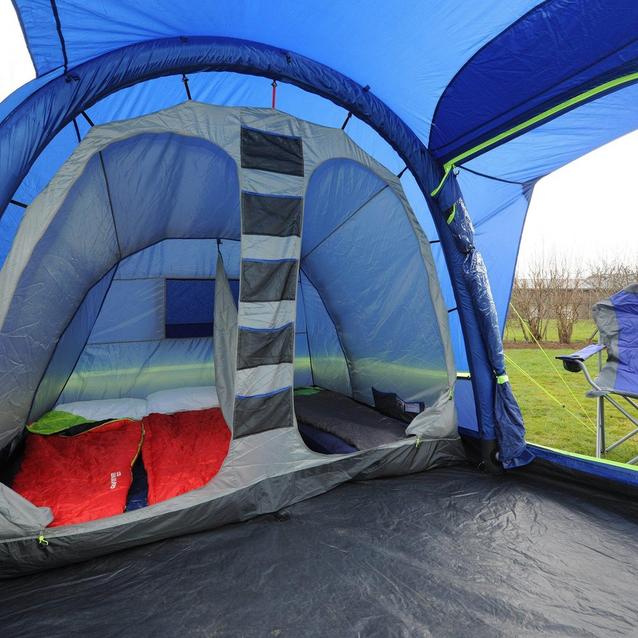
Berghaus Air 4 interior – roomy sleeping area, large living room
Space per head
I consider 65 cm per head the average across the market, including much more expensive tents – what I mean by that is that you probably won’t get any more even in a 6-person air tent costing above a grand. Depending on the number of people who actually going to use the tent, 60 cm per head could be enough – I couple for example could easily chuck a large inflatable mattress inside the 240 by 210 cm bedroom.
Number of bedrooms
Again, depending on how many people are going to use it, and what their relationship is…I mean, if you are camping with two smaller children it may be perfectly fine, as long as you don’t mind sleeping close to each other. Alternatively, you can save space with a bunk-bed for example.
Having two bedrooms however does increase the versatility – you can always remove the divider if you need one large bedroom.
The roomiest small family air tent
- Berghaus Air 4
- Pavillo Sierra Ridge Pro 4
- Eurohike Air 400
- Quechua Air Seconds 4.1
- Eurohike Genus 400
Weather protection
It’s getting a bit difficult here, as the Eurohike Air 400 and the Berghaus Air 4 play slightly above the league of the rest. These two have sewn-in groundsheets, while the others have loose that are secured to the flysheet by velcro.
Loose groundsheet vs sewn-in groundsheet
I’ve dedicated entire post to explain what difference it makes – Best Air Tents with Sewn-in Groundsheet – and if having a sewn-in groundsheet is that important. Loose groundsheets have some advantages too, like better ventilation and airflow, less condensation, easier cleaning etc.
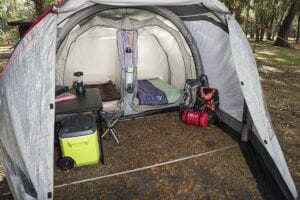
Pavillo Sierra Ridge PRO – rolled up groundsheet. You can’t do this with a sewn-in groundsheet
Though, most of the time, the loose groundsheet does not attach to the main / side doors, so there ALWAYS be a gap between the groundsheet and the door. If you are lucky only the cold comes in, if you are less lucky, water comes in too. If you don’t mind a bit of DIY it may be worth adding some velcro to be able to seal that gap at the doors.
Flysheet
As for the flysheet, the factor most often looked at for easier comparison is the HH, which is short for Hydrostatic Head. This number basically tells you, how waterproof the fabric is. (more on the topic, and other acronyms here: Tent materials, fabrics, specifications and all the acronyms. FAQ.)
The problem is that it does not tell you how waterproof the tent itself. You can have a 10,000 HH flysheet if the zips are not waterproof, or the fabric rips where the guylines are attached and the whole tent collapses in stronger winds.
I also appreciate the brow over the side door of the Berghaus Air 4 and the front door of the Quechua Air Seconds 4.1
Frequent usage & deterioration
Apart from the Berghaus Air 4, and probably, the Eurohike Air 4, these tents are not designed to be used over months. If you intend to use them a lot – even if it’s only in the back of your garden – then they are probably not the best choice.
It’s only the Quechua Air Seconds 4.1 that warns you on their product page, that the PU coating that has water repellent properties, will brake down under natural sunlight (UV light). That’s despite the UV protective layer. So they warn you that their tents are designed for ‘occasional use’ for a maximum of 4 weeks per year.
On the other hand, Quechua provides 5 years warranty, so probably that’s how they can provide it, and nothing happens if you happen to have the Air Seconds 4.1 pitched for more than 4 weeks a year.
I don’t think that the other tents, especially the Genus 400 and the Pavillo Sierra Ridge are any different, or more durable.
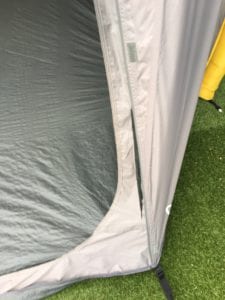
Poor quality flysheet ripped at the stiches on an earlier generation Genus 400
Overall weather protection
From experience, user reviews and information available online there are two that have good reputation – the Berghaus Air 4 (robust build quality, 6000 mm HH flysheet) and the Quechua Air Seconds 4.1 (Tropical rain and wind tunnel tested). So I’ve them to on top of this very subjective list.
The Eurohike Air 400 came in steady 3rd, followed by the Genus 400. I must add that the Genus 400 has the lowest quality fabrics of the 5, but it has some decent reviews highlighting how well it coped in wind and rain.
On the other hand, the Pavillo Sierra Ridge Pro has received mixed reviews, and some people complained about water leaking in.
True for all of these tent, as a rule of thumb, you must get an extra footprint and/or carpet to protect the groundsheet and at the end of every camping season re-proof the flysheet and the seams (as UV light can break down the waterproof layer over time) – I recommend Nikwax for that.
The best small family air tent for weather resilience;
- Berghaus Air 4
- Quechua Air Seconds 4.1
- Eurohike Air 400
- Eurohike Genus 400
- Pavillo Sierra Ridge Pro 4
User friendliness
I’ve tried to consider a lot of factors here from the weight of the tent (how easy it is to carry), what’s included in the bag (however it’s almost identical for all 5), number of doors / windows etc.
Weight
From that respect, the Genus 400 is the lightest under 10 kgs, while the others weigh around 15 kilos. So there is not a big difference, they are all pretty easy to handle and carry, they all come in a carrybag. Everything that you buy on top of the tent itself – carpet, footprint etc. – will come on top of this. You probably ask why the Genus 400 is so lightweight: well, that’s down to the weight of the fabrics used. The Genus 400 has a thinner, lighter flysheet material than the others.
Pitching
Pitching is easy with any inflatable tent of this size. The bedrooms are pre-attached in all, and they can be de-attached. The pump is normally included with the tent – with Quechua being the only exception, however this gives you the freedom to buy any pump you want, such as an electric pump like this one by Kampa. Just to make things even smoother.
Then the only thing you need to do is pegging out the corners, attaching the nozzle of the pump to the air valve, inflating them one-by-one and then pegging out the flysheet.
Usability
There’s one thing worth noting is that the Quechua Air Seconds and the Genus 400 don’t have side doors, the other three have. This may not be that big of an issue, but bear in mind that it also affects your ability to create a steady draught across the tent in warmer weather.
Bedrooms
The Eurohike Air 400 and the Air Seconds are the ones with darkened bedrooms.
Storage / pockets
The Genus 400 is not very generous with storage pockets. The Quechua is generally good with pockets and despite not having a divider between the bedrooms, they found place for plenty of cubby holes. The other three have the space for 4 pockets between the two bedrooms.
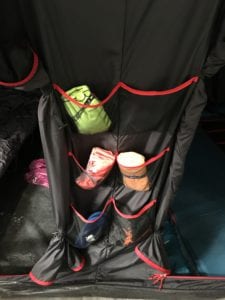
Storage pockets
Other Features
The Berghaus Air 4 and the Quechua Air Seconds 4.1 has some really nice features like the rain-brow over the side door.
The most user-friendly small family air tent
- Berghaus Air 4
- Eurohike Air 400
- Quechua Air Seconds 4.1
- Pavillo Sierra Ridge
- Genus 400 split 4th place – 4 points
Upgrades
Berghaus Air 4
The strongest contender in this section is the Berghaus Air 4, as Berghaus has an additional porch that is compatible with all Berghaus air tents. Bear in mind though, that the Berghaus porch is almost as expensive as the tent itself.
There is also a matching footprint and a bespoke carpet available for the Berghaus Air 4.
Eurohike Air 400 and Genus 400
The Eurohike Air 400 also has a footprint and a carpet available, but not other accessories. All the Eurohike carpets are ‘universal’, so they won’t exactly match in size with the Air 400, in return, you can use them for the Genus 400 as well.
The Genus 400 has a bespoke carpet too, but it’s only sold by GoOutdoors.
There is also a canopy that fits onto the Genus 400, extending the porch area. It is not expensive and seems like a really good add-on to the Genus 400.
Quechua Air Seconds 4.1 F&B
Quechua are generally good with accessories, upgrades and replacement parts. The Air Seconds 4.1 seems to be the exemption, as I could not find a matching footprint for this tent.
There are plenty of tent carpets that can go in the Air Seconds 4.1 but none of them are bespoke.
On the other hand, if anything goes wrong, it is very likely you will find spare parts for the Air Seconds 4.1; anything from flysheet, groundsheet and bedroom etc.
The small family air tent with the most upgrades available;
- Berghaus Air 4
- Eurohike Air 400
- Eurohike Genus 400
- Quechua Air Seconds 4.1
- Pavillo Sierra Ridge Pro Air 4
Warranty
I did not include it in the comparison, but I believe Quechua deserve one point deducted for offering 5 years warranty. All the others come with 30-day return and 12 months warranty.
